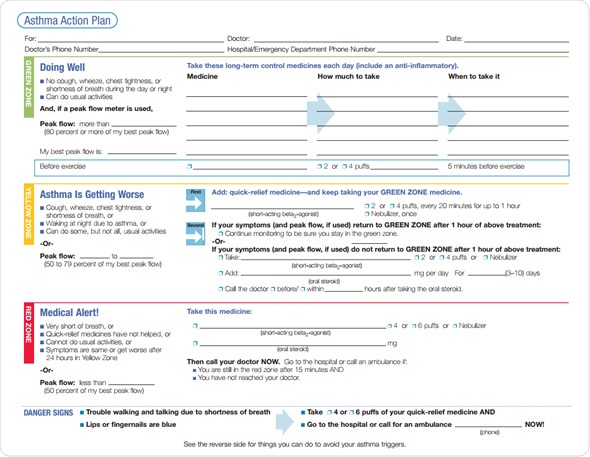
Using an Asthma Action Plan
An asthma action plan is a written series of steps and management techniques that should be used when a patient with asthma experiences worsening in symptoms of the condition.
The aim of an asthma action plan is to enable patients and caregivers to recognize early warning signs of an asthma attack and take the appropriate steps to improve control of the condition and minimize complications.

Image Copyright: Lopolo, Image ID: 249852262 via Shutterstock
What is an Action Plan?
An asthma action plan is a written, step-by-step guide to enable patients to maintain control of their asthma symptoms. It is usually made by the patient and health professional together and outlines what to do when:
- Asthma is well controlled
- There is a flare up of asthma symptoms
- An asthma attack occurs
The plan will usually list any triggers, remind patient when to take which medication and stipulate how bystanders can help if an attack occurs.

Click here or the image to view an Asthma Action Plan from Asthma Action Plan from the US National Institutes of Health (PDF)
Benefits
Research has supported the benefits that a written asthma plan can offer when individuals are managing asthma in the home environment. It helps to:
- Establish clear guidelines on when and how to act in response to certain changes and symptoms related to the condition.
- Monitor changes and understand when the condition is well-controlled o pharmacological treatment alterations are needed.
- Provide patients with the knowledge of when to act and seek emergency medical aid.
An asthma action plan assists in the communication between the healthcare practitioner and the patient, allowing relevant information to be clearly presented in a written and easy-to-follow format. It doesn’t take long to discuss and write up the action plan but the benefits of the plan are clear. In fact, individuals that have an action plan are four times less likely to require hospitalization to manage severe symptoms.
Daily Maintenance
The everyday section of the action plan should detail the regular medications and management techniques that should be employed to prevent symptoms as asthma.
This often includes the avoidance of asthma triggers, in addition to preventative medication to reduce inflammation of the airways. Reliever medication is also indicated when symptoms worsen for a short period of time.
Flare-Ups
Flare-ups of asthma symptoms are most likely to occur when individuals have been exposed to triggers of asthma or have recently been ill with a cold or influenza. These periods are marked by increased use of reliever medication or a reduction in peak expiratory flow (PEF) values at home, and should be considered as a warning sign to initiate treatment to prevent an attack.
The plan will differ according to the needs of each individual, but often involves a “step up” approach in medications or a short course of corticosteroids to manage inflammation
Emergency Action
An asthma plan plays an essential role to guide decision-making when in an emergency situation such as an asthma attack. It is marked by the significant worsening of symptoms such as difficulty breathing, chest tightness and wheezing.
The plan should be easily accessible for other members of the family to refer to and help in the management of the attack. In most cases, reliever medication should be administered, and an ambulance should be called if no improvement occurs.
Other Advice
It is important that the asthma action plan is reviewed and updated regularly, at least annually, to ensure the plan is suitable for the individual case.
Additionally, the action plan can only be utilized if the patient has it on hand when it is needed. If should be located in a place at home that allows people to see it and refer to it quickly when needed. It can also be useful to make several copies to be kept in other areas, such as in the car, at school and the sporting club.
References
- https://www.asthma.org.uk/advice/manage-your-asthma/action-plan/
- https://www.nhlbi.nih.gov/files/docs/public/lung/asthma_actplan.pdf
- http://www.asthma.ca/adults/control/pdf/AsthmaActionPlan_ENG.pdf
- http://www.asthma.ca/adults/control/actionPlan.php
Further Reading
Last Updated: Aug 23, 2018

































No hay comentarios:
Publicar un comentario